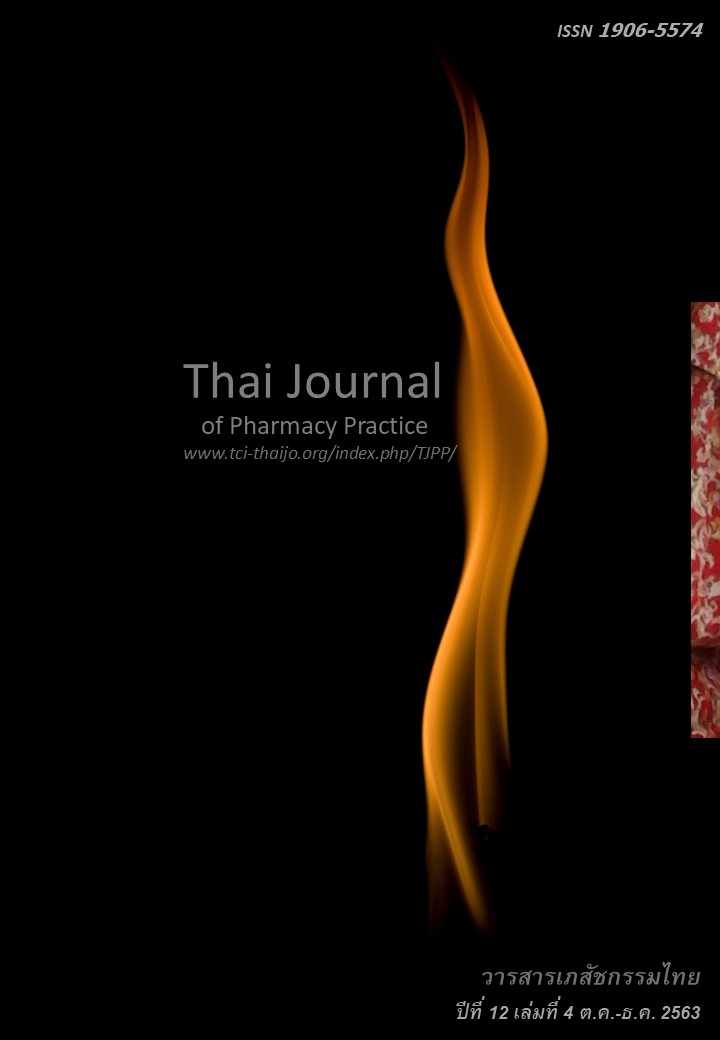โมเดลเชิงนิเวศวิทยาของการเกิดวัณโรคดื้อยาหลายขนานในโรงพยาบาลแม่สอด จังหวัดตาก
Main Article Content
บทคัดย่อ
วัตถุประสงค์: เพื่อศึกษาปัจจัย 5 ระดับของการเกิดวัณโรคดื้อยาหลายขนานของโรงพยาบาลแม่สอดด้วยโมเดลเชิงนิเวศวิทยา คือ ปัจจัยภายในตัวบุคคล ระหว่างบุคคล องค์กร ชุมชน และนโยบายสาธารณะ วิธีการ: งานวิจัยนี้เป็นการวิจัยเชิงคุณภาพที่เก็บข้อมูลโดยการสัมภาษณ์เชิงลึกในผู้ป่วยวัณโรคดื้อยาหลายขนานรายใหม่ 10 ราย ซึ่งอยู่ระหว่างการรักษา ณ คลินิกวัณโรค โรงพยาบาลแม่สอด รวมถึงญาติหรือผู้ดูแล 7 ราย และบุคลากรที่ให้บริการคลินิกวัณโรค 6 รายในช่วงเดือนกันยายนถึงธันวาคม พ.ศ. 2561 การศึกษาใช้การวิเคราะห์แก่นสาระและตรวจสอบข้อมูลแบบสามเส้าจากแหล่งที่มาของข้อมูล ผลการวิจัย: ความไม่ร่วมมือในการรักษาของผู้ป่วยซึ่งอาจนำสู่การดื้อยาหลายขนานนั้น เป็นยอดภูเขาน้ำแข็งที่สืบเนื่องจากหลายปัจจัย ทั้งอาการไม่พึงประสงค์จากยาที่รบกวนการดำเนินชีวิต ระยะเวลาการรักษาที่นานทำให้ผู้ป่วยกังวลว่าอาจไม่สามารถรักษาให้หายได้ จึงเกิดความท้อแท้ แยกตัวออกจากชุมชน และปกปิดตัวเองเพราะกลัวสังคมรังเกียจ ขณะเดียวกันทัศนคติต่อโรคของญาติมีผลต่อท่าทีการช่วยดูแล ซึ่งมีผลต่อกำลังใจของผู้ป่วยมาก สิ่งแวดล้อมและขั้นตอนการให้บริการที่ไม่เป็นระบบและล่าช้าทำให้ผู้ป่วยไม่อยากเข้ามารับบริการ ในขณะที่เจ้าหน้าที่มีภาระงานที่เพิ่มขึ้นจากนโยบายวัณโรคต่าง ๆ แต่ผู้ป่วยและญาติกลับไม่ทราบถึงนโยบายดังกล่าว สรุป: ปัจจัยทั้ง 5 ระดับตามโมเดลเชิงนิเวศวิทยามีความเชื่อมโยงไปสู่การส่งเสริมให้เกิดวัณโรคดื้อยาหลายขนานได้ทั้งทางตรงและทางอ้อม การสร้างความเข้าใจต่อโรคและการรักษาแก่ผู้ป่วยและญาติ รวมถึงการปรับนโยบายที่เกี่ยวกับวัณโรคให้เข้ากับสถานการณ์ปัจจุบัน มีความต่อเนื่อง และเอื้อต่อการปฏิบัติจริง อาจเป็นจุดคานงัดสำคัญของการแก้ปัญหา
Article Details
ผลการวิจัยและความคิดเห็นที่ปรากฏในบทความถือเป็นความคิดเห็นและอยู่ในความรับผิดชอบของผู้นิพนธ์ มิใช่ความเห็นหรือความรับผิดชอบของกองบรรณาธิการ หรือคณะเภสัชศาสตร์ มหาวิทยาลัยสงขลานครินทร์ ทั้งนี้ไม่รวมความผิดพลาดอันเกิดจากการพิมพ์ บทความที่ได้รับการเผยแพร่โดยวารสารเภสัชกรรมไทยถือเป็นสิทธิ์ของวารสารฯ
เอกสารอ้างอิง
World Health Organization. Global tuberculosis report 2018 [online]. 2019 [cited May 4, 2019]. Available from: www.who.int/tb/publications/global_report/en/
Hof Svd, Collins D, Hafidz F, Beyene D, Tursynba yeva A, Tiemersma E. The socioeconomic impact of multidrug resistant tuberculosis on patients: results from Ethiopia, Indonesia and Kazakhstan. BMC Infect Dis. 2016; 16: 1-14
Morris MD, Quezada L, Bhat P, Moser K, Smith J, Perez H, et al. Social, economic, and psychological impacts of MDR-TB treatment in Tijuana, Mexico: A patient's perspective. Int J Tuberc Lung Dis. 2013; 17: 954-60.
Yadav SK, Damor R, Kantharia SL, Tiwari M. Assess ment of effect of MDR-TB/TB on social, functional and economic well-being of patients – a cross sectional study. J Evid Based Med Healthc. 2015; 2 :3812-20.
World Health Organization. WHO end TB strategy 2014 [online]. 2015 [cited May 4, 2019]. Available from: www.who.int/tb/post2015_strategy/en/.
Gennaro FD, Pizzol D, Cebola B, Stubbs B, Monno L, Saracino A, et al. Social determinants of therapy failure and multi drug resistance among people with tuberculosis: a review. Tuberculosis. 2017;103:44-51.
Siroka A, Ponce NA, Lönnroth K. Association between spending on social protection and tubercu losis burden: a global analysis. Lancet Infect Dis. 2016; 16 :473-9.
Odone A, Calderon R, Becerra MC, Zhang Z, Contre ras CC, Yataco R, et al. Acquired and transmitted multidrug resistant tuberculosis: the role of social determinants. PloS one. 2016; 11: e0146642.
McLeroy KR, Bibeau D, Steckler A, Glanz K. An ecology perspective on health promotion programs. Health Educ Q 1988; 15: 351-77.
Isaboke JN. Risk factors for tuberculosis and multi drug-resistant tuberculosis complications among foreign-born persons in Houston, Texas. Texas: Walden University 2016.
Tansakul S. Behavioral theories: practices in health education and promote health. Journal of Health Education 2007;30:1-15.
Tupasi TE, Garfin AMCG, Kurbatova EV, Mangan JM, Chi RO, Naval LC, et al. Factors associated with loss to follow-up during treatment for multidrug-resistant tuberculosis, the Philippines, 2012–2014. Emerg Infect Dis. 2016 ;22: 491-502.
Tschirhart N, Thi SS, Swe LL, Nosten F, Foster AM. Treating the invisible: gaps and opportunities for enhanced TB control along the Thailand-Myanmar border. BMC Health Serv Res. 2017;17 :1-11.
Bureau of Tuberculosis. Reach-recruit-test-treat-retain: RRTTR (stop TB and AIDS through RTTR: STAR). Nontaburi: Aksorn Graphic and Design Publishing House; 2015.
Braun V, Clarke V. Using thematic analysis in psychology. Qual Res Psychol. 2008; 3: 77-101.
World Health Organization. Bending the curve - ending TB: annual report 2017. India: World Health Organization, Regional Office for South-East Asia; 2017.
Choowong J, Maneechote P, Sawatdee D. People with tuberculosis in Thailand: impacts of stigma and directly observed treatment practice guidelines. Southern College Network Journal of Nursing and Public Health. 2018; 6: 237-45.
Elmi OS, Hasan H, Abdullah S, Jeab MZM, Alwi ZB, Naing NN. Multidrug-resistant tuberculosis and risk factors associated with its development: a retro spective study. J Infect Dev Ctrie. 2015; 9 : 1076-85.


